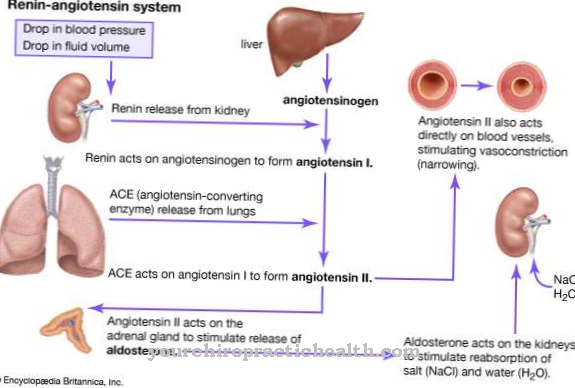The medical term Blood pressure is used over and over again without most people knowing exactly what is behind it. In the following you will learn more about healthy blood pressure and about diseases that can result from high or low blood pressure.
What is blood pressure
The blood circulates within the blood vessels in the body and is subject to various processes. A very significant factor that can be observed in this context is that Blood pressure.
Blood pressure is a parameter that results from a force (pressure) with which the blood flows through the vessels and organs. This force is represented as the physical quantity pressure and can be measured with appropriate medical instruments.
In the case of blood pressure, a distinction is made between the systolic and diastolic values depending on the physiological processes. Mean blood pressure and so-called pulse pressure are less common. All factors are subject to special age-dependent normal ranges.
Examine & measure blood pressure (normal value & healthy blood pressure)
The normal values at Blood pressure are around 120 mmHg systolic and around 80 mmHg diastolic blood pressure in adults. Excessive or excessively high, pathological blood pressure can be assumed if the measurements result in values of more than 140/90 mmHg. This excess is known as hypertension or high blood pressure. If the measurement result is less than 100/60 mmHg, there is hypotension or blood pressure that is too low.
In people who have reached an advanced age, blood pressure around 140/90 mmHg is considered normal. In children, the acceptable blood pressure is usually a little below 100/60 mmHg or around 110/70 mmHg. In addition, blood pressure is subject to natural fluctuations.
By measuring blood pressure with a stethoscope inl. The majority of patients know about sphygmomanometers from their own experience. When determining blood pressure, doctors differentiate between a direct, a palpatory and an indirect method.
The most common procedure is to measure blood pressure based on the sounds audible through a stethoscope, which the blood makes as it travels through the vessels. With this principle, the systolic blood pressure, at which the blood flows unhindered because the pressure through the cuff is reduced, and the diastolic blood pressure are recorded.
This builds up when the blood flow in the vessel is interrupted by a pressure cuff. Blood pressure is always measured on an artery because it leads away from the heart. In addition to the upper arm artery near the heart, a leg artery can also be sought. In addition, there are physical restrictions on measuring blood pressure.
Function, effect & tasks
Of the Blood pressure is the basis for the fact that the blood can be pressed into even the smallest capillary vessels and also reaches the brain when the person walks upright.
The arteries that carry the blood that is pressed out by the heart are subject to what is known as arterial pressure. This is not maintained arbitrarily and independently of the entire organ system, but is specifically regulated. Under these circumstances, the arterial blood pressure reacts to physical strain or additional stress and can decrease again when the patient is resting.
The regulation of blood pressure is based on a complicated mechanism that is influenced by a large number of hormonal, enzymatic, neural and vascular-specific anatomical components.
Diseases
In connection with the pathological (morbid) abnormalities that occurred during Blood pressure are to be examined, there are arterial hypertension and peripheral venous hypertension, hypotension and portal hypertension. In cardiology and general medicine, a distinction is made between pathological conditions of blood pressure such as pulmonary hypertension and excessive venous blood pressure in the large central veins.
These diseases are not that common. It is more or less the sequelae on other organs and the entire cardiovascular system that worries people in connection with blood pressure. Experienced doctors and medical professionals do not see too low blood pressure as a special risk factor, but rather too high blood pressure.
Hypertension usually has several stages and also has varying diagnoses. If left untreated, a permanently high blood pressure leads to a loss of function of the heart (heart failure) and other massive consequential damage for those affected.
Typical & common diseases
- high blood pressure
- Low blood pressure (hypotension)
- Fluctuations in blood pressure
- High blood pressure during pregnancy (preeclampsia)
- Heart attack
- Arterial hypertension






.jpg)

















.jpg)



